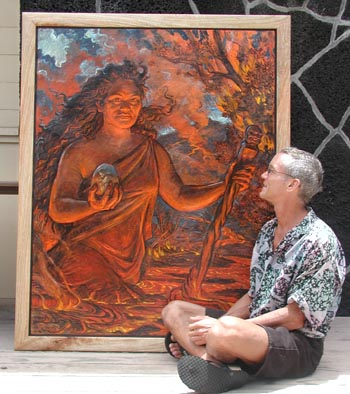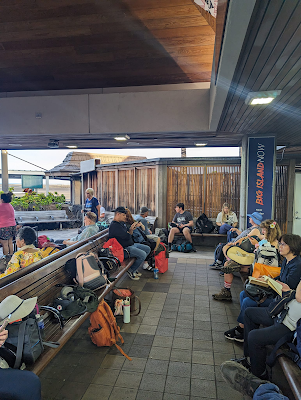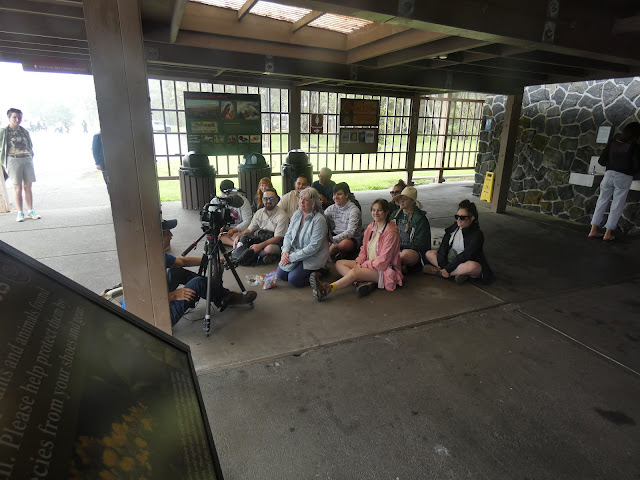So you want to demonstrate a volcanic eruption for your field geology course, and are unsure how to proceed? Let the crew (of one) here at Geotripper help you to plan out the very best eruption experience for your students! There are several important steps and considerations:
1) Pick a volcano
This is a pretty important first step. Some volcanoes can be very dangerous, and we at Geotripper feel that safety is a hugely important consideration. We have chosen the Big Island of Hawai'i for our demonstration, as eruptions there TEND to be on the quiet side, although there are important exceptions.
 |
| Kilauea Caldera and Kilauea Iki in the distance |
2) Do a site evaluation
Take a hike out to the potential eruption site. This is kind of critical, because we want to choose a site that is isolated and away from buildings and populated areas. Yet we also want the site to be visible once the eruption begins, since this is the whole point of planning such things.
 |
| Hiking out to the Ka'u Desert ("Footprints Trail") on May 29, 2024 |
3) Consult with the local volcanic deities:
 |
| Painting of the Hawaiian goddess Pele at the Kilauea Visitor Center with the artist, Arthur Johnson (Source: NPS). |
Once again a critical factor. One doesn't conduct eruptions without the permission and cooperation of the deities that inhabit the place. In our current example we are dealing with Pele, also known as Pele-honua-mea ("Pele of the sacred land") and Ka wahine ʻai honua ("The earth-eating woman").
A side note: the gist of this post is tongue-in-cheek, but I take Pele pretty seriously. Check out my interaction with a mysterious woman on the flanks of Kilauea a few years ago. Who was she??
4) Start the Field Trip
Taking twenty students to the Hawaiian Islands for two weeks is no small task, and we here at Geotripper strongly suggest planning the trip many months in advance of the eruption. Remember to consider such logistics as hotels, transportation, airline flights, food, and group interpersonal interactions.
5) Educate your students on the basics of volcanoes and vulcanism
There are many ways to do this. One of my favorites is to pay a visit to the
Hawaiian Volcano Observatory (currently based in Hilo, Hawai'i after their original home on the brink of the Kilauea caldera was damaged by an eruption in 2018). Our expert host provided an excellent introduction to the methods and technology of volcano monitoring.
6) Subtly prepare the group for the experience of the eruption
This step requires some public relation skills. We don't want to have the experience spoiled by high expectations and the like. We want our group to be both surprised and prepared when the eruption happens. There are a number of ways to do do this. For instance, have them look at seismic records and see if they notice the uptick in earthquakes in recent days. Ask a Hawaii Volcanoes National Park ranger leading questions like "why did you close the Devastated Area Trail yesterday?" You can make jokes, like "Wouldn't it be interesting if an eruption were to happen while we are on the trip?". Don't overdo it, though.
7. Conduct the Eruption
In many ways this is the easiest step, since the Earth does all the work. If you arrange for the eruption overnight, you can plan on an early departure from the hotel to beat the tourists to all the best overlooks. If you have prepared in the way that we have put forth here, your students will be duly impressed even if they can't stick things into the lava flow or even see spewing lava. Seeing the ash and steam rising from the distant rift zone will be more than enough!
Oh, I see a hand in the back...what was your question? How do we actually cause the eruption to happen at the perfect time? Oh, it's kind of complicated. We don't really have time enough to explain...
8. Provide a cooling down period |
| Source: USGS Hawaii Volcanoes Observatory |
Here's my video of the eruption from the site of the old Jagger Museum and Hawaiian Volcano Observatory: https://vimeo.com/959288135?share=copy





1 comment:
That must have been really cool, thank you so much for sharing and teasing.
Post a Comment